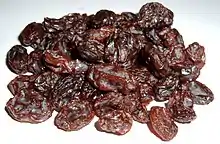չամիչ
Armenian
Alternative forms
- չամիչ (čʻamičʻ) — Akhaltsikhe, Goris, Ararat, Kharberd, Erzurum, Moks, Mush, Nor Nakhichevan, Constantinople, New Julfa, Tekirdağ, Sivas, Suceava, Van, Tbilisi
- չա̈միչ (čʻämičʻ) — Haçin, Maragheh, Salmas, Diyarbakır
- չա̈մէչ (čʻämēčʻ) — Svedia
- չամիճ (čʻamič) — Alashkert
- չա̈՛մինչ (čʻä́minčʻ), չա՛մէնչ (čʻámēnčʻ), չա՛մըէչ (čʻáməēčʻ) — Karabakh
- չամը՛չ (čʻamə́čʻ) — Zeitun
- չա՛մուչ (čʻámučʻ) — Agulis
- չօ՛մէնչ (čʻṓmēnčʻ) — Meghri

Etymology
From Old Armenian չամիչ (čʻamičʻ).
Pronunciation
Audio (Eastern Armenian) (file) - (Eastern Armenian, standard) IPA(key): [t͡ʃʰɑmít͡ʃʰ]
- (Western Armenian, standard) IPA(key): [t͡ʃʰɑmít͡ʃʰ]
Declension
| singular | plural | |||
|---|---|---|---|---|
| nominative | չամիչ (čʻamičʻ) | չամիչներ (čʻamičʻner) | ||
| dative | չամչի (čʻamčʻi) | չամիչների (čʻamičʻneri) | ||
| ablative | չամչից (čʻamčʻicʻ) | չամիչներից (čʻamičʻnericʻ) | ||
| instrumental | չամչով (čʻamčʻov) | չամիչներով (čʻamičʻnerov) | ||
| locative | չամչում (čʻamčʻum) | չամիչներում (čʻamičʻnerum) | ||
| definite forms | ||||
| nominative | չամիչը/չամիչն (čʻamičʻə/čʻamičʻn) | չամիչները/չամիչներն (čʻamičʻnerə/čʻamičʻnern) | ||
| dative | չամչին (čʻamčʻin) | չամիչներին (čʻamičʻnerin) | ||
| 1st person possessive forms (my) | ||||
| nominative | չամիչս (čʻamičʻs) | չամիչներս (čʻamičʻners) | ||
| dative | չամչիս (čʻamčʻis) | չամիչներիս (čʻamičʻneris) | ||
| ablative | չամչիցս (čʻamčʻicʻs) | չամիչներիցս (čʻamičʻnericʻs) | ||
| instrumental | չամչովս (čʻamčʻovs) | չամիչներովս (čʻamičʻnerovs) | ||
| locative | չամչումս (čʻamčʻums) | չամիչներումս (čʻamičʻnerums) | ||
| 2nd person possessive forms (your) | ||||
| nominative | չամիչդ (čʻamičʻd) | չամիչներդ (čʻamičʻnerd) | ||
| dative | չամչիդ (čʻamčʻid) | չամիչներիդ (čʻamičʻnerid) | ||
| ablative | չամչիցդ (čʻamčʻicʻd) | չամիչներիցդ (čʻamičʻnericʻd) | ||
| instrumental | չամչովդ (čʻamčʻovd) | չամիչներովդ (čʻamičʻnerovd) | ||
| locative | չամչումդ (čʻamčʻumd) | չամիչներումդ (čʻamičʻnerumd) | ||
Derived terms
- չամիչխաղող (čʻamičʻxaġoġ)
- չամչապուր (čʻamčʻapur)
- չամչարակ (čʻamčʻarak)
- չամչել (čʻamčʻel)
- չամչենի (čʻamčʻeni)
- չամչի (čʻamčʻi)
- չամչկենի (čʻamčʻkeni)
- չամչմել (čʻamčʻmel)
References
- Ačaṙean, Hračʻeay (1977) “չամիչ”, in Hayerēn armatakan baṙaran [Armenian Etymological Dictionary] (in Armenian), 2nd edition, a reprint of the original 1926–1935 seven-volume edition, volume III, Yerevan: University Press, page 623a
Old Armenian
Etymology
Usually considered of unknown origin.[1][2][3]
Probably a Semitic borrowing: compare Assyrian Neo-Aramaic ܟܡܝܫܐ (kmiša, “dried up, dry, shrivelled (of grapes in a drought)”),[4] ܟܡܫ (kamiš, “to become dry, become scorched, dehydrate; to fade, wither, shrivel up, wilt”).[5][6] Note that here k and š are both pronounced as an emphatic /t͡ʃ/.[7] Accordingly, these are usually transcribed as č̣mič̣a, č̣aməč̣.[8][9][10] Ačaṙyan treats the Assyrian Neo-Aramaic words as Armenian borrowings, but they have native origin from the Aramaic root ܟ-ܡ-ܫ (k-m-š, “to wither”),[11][12][13] whence Aramaic / Classical Syriac [script needed] (kmyš) / ܟܡܝܫܐ (kmyšʾ /kəmīšā/, “wrinkled”), Classical Syriac ܟܡܫܘܢܐ (kmšwnˀ /kamšōnē/, “grape seed, dried raisin”).
Noun
չամիչ • (čʻamičʻ)
Usage notes
According to Ačaṙean, ի չամչոյ մինչեւ ցթինն (i čʻamčʻoy minčʻew cʻtʻinn, “from the raisin to the grapeseed”) in Numbers 6:4 should be amended to ի չանչոյ մինչեւ ցթինն (i čʻančʻoy minčʻew cʻtʻinn, “from the grape pomace to the grapeseed”), because the Septuagint correspondent is στέμφυλον (stémphulon, “mass of pressed grapes”).
Declension
| singular | plural | ||
|---|---|---|---|
| nominative | չամիչ (čʻamičʻ) | չամիչք (čʻamičʻkʻ) | |
| genitive | չամչոյ (čʻamčʻoy) | չամչոց (čʻamčʻocʻ) | |
| dative | չամչոյ (čʻamčʻoy) | չամչոց (čʻamčʻocʻ) | |
| accusative | չամիչ (čʻamičʻ) | չամիչս (čʻamičʻs) | |
| ablative | չամչոյ (čʻamčʻoy) | չամչոց (čʻamčʻocʻ) | |
| instrumental | չամչով (čʻamčʻov) | չամչովք (čʻamčʻovkʻ) | |
| locative | չամիչ (čʻamičʻ) | չամիչս (čʻamičʻs) |
Derived terms
- չամչախունկ (čʻamčʻaxunk)
- չամչեայ (čʻamčʻeay)
- չամչեղէն (čʻamčʻełēn)
- չամչռեմ (čʻamčʻṙem)
Descendants
References
- Ačaṙean, Hračʻeay (1977) “չամիչ”, in Hayerēn armatakan baṙaran [Armenian Etymological Dictionary] (in Armenian), 2nd edition, a reprint of the original 1926–1935 seven-volume edition, volume III, Yerevan: University Press, page 623a
- Olsen, Birgit Anette (1999) The noun in Biblical Armenian: origin and word-formation: with special emphasis on the Indo-European heritage (Trends in linguistics. Studies and monographs; 119), Berlin, New York: Mouton de Gruyter, page 948
- J̌ahukyan, Geworg (2010) “չամիչ”, in Vahan Sargsyan, editor, Hayeren stugabanakan baṙaran [Armenian Etymological Dictionary] (in Armenian), Yerevan: Asoghik, page 611a
- “ܡܝܫ”, in Sureth Dictionary, Association Assyrophile de France, 2019 April 20 (last accessed)
- “ܟܡܫ”, in Sureth Dictionary, Association Assyrophile de France, 2019 April 20 (last accessed)
- “ܟܡܫ”, in Sureth Dictionary, Association Assyrophile de France, 2019 April 20 (last accessed)
- Khan, Geoffrey (2008) The Neo-Aramaic Dialect of Barwar (Handbook of Oriental Studies. Section 1 The Near and Middle East; 96), Leiden, Boston: Brill, page 62
- Kalašev, A. (1894) Русско-айсорский и айсорско-русский словарь (Сборник материалов для описания местностей и племен Кавказа; 20), Tiflis, page 398b
- Napiorkowska, Lidia (2015) A Grammar of the Christian Neo-Aramaic Dialect of Diyana-Zariwaw (Studies in Semitic Languages and Linguistics; 81), Leiden, Boston: Brill, pages 526, 570
- Khan, Geoffrey (2016) The Neo-Aramaic Dialect of the Assyrian Christians of Urmi (Studies in Semitic Languages and Linguistics; 86), volume III, Leiden, Boston: Brill, pages 135, 136
- “ܟܡܫ”, in Sureth Dictionary, Association Assyrophile de France, 2019 April 20 (last accessed)
- “kmš”, in The Comprehensive Aramaic Lexicon Project, Cincinnati: Hebrew Union College, 1986–, retrieved 2019-04-20
- Khan, Geoffrey (2008) The Neo-Aramaic Dialect of Barwar (Handbook of Oriental Studies. Section 1 The Near and Middle East; 96), Leiden, Boston: Brill, page 278
- Zēytʻunean A. S., editor (1998), Girkʻ Tʻuocʻ [Book of Numbers] (Hay hnagoyn tʻargmanakan yušarjanner), Antelias: Holy See of Cilicia, critical text, page 80
Further reading
- Awetikʻean, G., Siwrmēlean, X., Awgerean, M. (1836–1837) “չամիչ”, in Nor baṙgirkʻ haykazean lezui [New Dictionary of the Armenian Language] (in Old Armenian), Venice: S. Lazarus Armenian Academy
- Petrosean, Matatʻeay (1879) “չամիչ”, in Nor Baṙagirkʻ Hay-Angliarēn [New Dictionary Armenian–English], Venice: S. Lazarus Armenian Academy